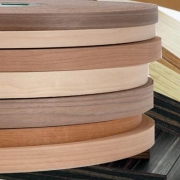How to Use Iron on Edge Banding

If you’re thinking about applying edge banding to a tabletop, you may be wondering how to go about it. There are some essential tips and tricks to remember, such as choosing the right tool and material, as well as adhering the edge band properly. You’ll also learn about how to maintain the durability of your finished project. Hopefully, these tips and tricks will help you learn how to use iron on-edge banding.
Tools
There are various tools for iron on-edge banding. Small irons work well for small projects, such as installing edge banding on cabinets. Larger irons are better suited for larger projects. A small iron, such as the WoodRiver, is not advisable for large pieces of furniture. A large iron, however, covers a much wider area and requires less pressing down. It also does not require flat objects or rollers.
A portable iron is another handy tool for edge banding. The Yodean Decor Veneer Edge Banding and Sealing Iron is lightweight and convenient for use on many different types of projects. This iron features an auto-cleaning system and temperature control dial. It is also equipped with a 360-degree swivel cord to allow you to easily maneuver around and use it efficiently. You can even use the iron for other applications as well, such as sealing plastic.
Techniques
There are a few different techniques you can use to apply iron-on edge banding. It is important to plan ahead in order to avoid visible joints and to minimize the amount of time you need to apply it. Once you have positioned the strip, turn on your iron and heat it for about four to six inches. This will help the adhesive cool down and make it easier to apply the strip. Move the iron along the edge and apply downward pressure to the banding.
Before applying the edge banding, remove any loose material. Make sure the wood is as level as possible and that the edge of the plywood is flat. You should also use a hot iron for maximum results. Heat the wood until the glue adheres. The wood should be warm, otherwise, it will cause a bumpy finish. Once the glue has set, trim the edges of the wood to fit. Once you’ve trimmed the edge banding, you can apply another coat of glue to ensure that it adheres properly.
Material
If you’re looking for a more affordable and convenient way to finish a project, consider installing iron on edge banding. Although this method does require some preparation, it doesn’t require specialized tools or glue. To apply this technique, you can purchase an iron in the right size for your project. To apply the strip, begin by locating the edge band with your hand and pressing it with the iron. Apply pressure with the iron, letting it cool for 1 minute after each pass. After this, use a utility knife to trim the excess material.
Use a low-cost iron for this task. A regular clothes iron may get sticky and cause damage to the soleplate. You can purchase a cheap iron at a discount retailer or thrift store. Be sure to use the cotton heat setting on your iron. Next, cut the edge banding so that it extends one inch past the edge of the piece. Make sure that the overhangs on each side of the edge banding are equal. Set the iron at one end of the edge banding. Move the iron in a slow, steady pace so that it does not scorch the material.
Durability
The final step in installing iron on edge banding is to make sure that it adheres to the plywood’s edge. While regular clothes irons may get adhesive on the soleplate, you should buy a low-cost iron designed for use on fabrics and use the cotton heat setting. Start at one end of the plywood edge banding and move the iron slowly across it, making sure to keep the edges level. Once the adhesive cools, trim the excess banding.
A high-quality iron on edge banding will withstand a lot of abuse. While some people may wonder whether an iron on edge banding is really as durable as it is advertised to be, you can be sure that this material will last for years. And if you are concerned about the appearance of the edge banding, you can opt for wood veneer edge banding, which is a high-quality veneer that is applied to the edges of plywood. The veneered edge banding is an excellent choice if you want to give your plywood a solid-wood look. The edge banding will not only give your plywood a nice finish, it will also protect the inner layers from damage.
Application
Applying iron on edge banding is easy and should not leave a visible joint. Before starting, prepare the area in which the edge banding will be applied. Make sure the area is well-ventilated. For the best results, position the banding with one hand and heat the iron. Apply heat to 4 to 6 inches of banding first. Let the adhesive cool for about one minute. Apply downward pressure while moving the iron over the edge banding.
For the best results, use the recommended edge banding iron. Some edge banding materials are hard to find. If this is the case, consider making your own. You can use scissors, a veneer saw, hot melt adhesive and a clothes iron to create the desired look. Applying edge banding can take some time, but is well worth the end result. Once you have your edge banding applied, you can apply conventional wood finishing products.




Leave a Reply
Want to join the discussion?Feel free to contribute!